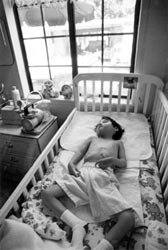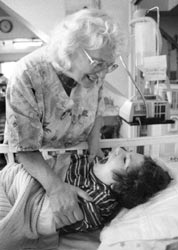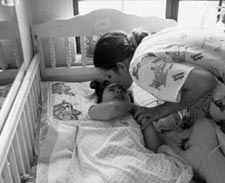FYI: What the de Groot home needs most in the way of donations is formula.
‘Make This Story Happy’
Sjany de Groot Spends Every Day Caring for 13 Terminally Ill Children and Accenting the Positive
BY JEN STEVENSON
Photos by Jeff Greene
How remarkable that Sjany de Groot’s 13 children are happy.
Happy although most of them will never walk, and although many depend on small plastic tracheal tubes strapped to their necks for the very air they breathe. Happy despite the unavoidable fact that in the not-too-distant future they will die.
These critically ill children lie in a comfortable nursery inside Sjany's large San Luis Obispo home, their broken bodies safe within its sanctuary. For them, the home is a bower of love and peace.
and peace.
Their happiness can be seen in their wide, toothy smiles, heard in their gasping and gurgling as they struggle to laugh.
They know no regret, harbor no resentment, though they have been forsaken by Mother Nature, ruined by drugs and alcohol before they saw the outside of the womb, beaten and abused.
The only emotion in their eyes is trust, trust inspired by Sjany de Groot. A trust that can’t be broken by Medicare cutbacks nor by offers of a million dollars to sell her "business" to health care conglomerates.
***
It's early on a gloomy Thursday morning, and another ordinary day in the de Groot home nursery, where 15 cribs are arranged around the room, 13 of them filled with children in various stages of sleep.
The large, L-shaped nursery has an unmistakable smell: formula mixed with soiled diapers, vomit mingled with freshly washed linens.
As the night nurse departs at 7 a.m., Sjany De Groot–who rises each morning at six–has already begun her morning rounds, standing alone in a small tiled room off to one side of the nursery, pouring cans of formula into feeding bags.
The 72-year-old is the mother of seven, grandmother of 14, surrogate mother to 13.
She goes from crib to crib, deftly unclipping and reattaching the bags to thin clear rubber tubes that snake out from a hole in each child’s navel, providing them the only type of nourishment their damaged little bodies can handle. Still, many of them vomit throughout the day, she explained. They can't help it.
The nursery is still blanketed in the relative silence of early morning. A tape player softly plays cheerful little children's tunes. "The wheels on the bus go round and round, all through the town," sings a happy voice.
Underneath the music, there are soft murmurs and the omnipresent gasping sounds many of the children emit as they struggle to breathe through their "trachs"–plastic tubes inserted into their tracheas, or windpipes.
This has been Sjany's morning routine for 26 years, since she first accepted a critically ill child into her home, thereby changing her life and the lives of many others.
Although Sjany’s a skilled registered nurse, she cannot do it alone. The two morning assistants and her 15-year-old daughter Susie arrive one by one, and immediately fall into the routine.
Beyond the nursery, the bedroom Sjany and her husband occupy is visible, separated from the nursery only by an accordion door that is usually open. From a small daybed against the far wall, a tiny girl waves at Sjany. It’s her adopted daughter Melissa.
"I am coming to get you," Sjany calls back in her thick Dutch accent. Melissa cannot walk; her frail legs are unable to support her small body.
After Sjany helps Melissa get ready, the little girl scoots into the nursery on her hands and knees, her main means of transport inside the house. Dressed in tiny scrubs emblazoned with flying pigs, she flies from crib to crib on her knees, wiping the bars with a wet cloth. The irony of her flying pigs is not lost–she is here against all odds, having been expected to die when much younger. Today, the 13-year-old exudes life. She’s the star of the household.
Turning her little heart-shaped face to the now-silent tape recorder, Melissa announces, "Hey, we need some music in here!"
In a flash, her favorite nursery tape is playing–Kenny Loggins. Melissa sings along out loud, her voice slightly nasal, affected by the scarred hole in her throat where her own plastic trach used to be.
"She wants to be a singer someday," Sjany said, looking at her daughter with pride. "Melissa was very critical, now look at what we have. They said she had no chance, but she made it. She keeps everybody going. She'll wake up in the middle of the night and call out, ‘I love you, Mom.’ "
Melissa's high voice can be heard throughout the nursery as she goes from crib to crib, greeting each child.
"Hi Davin, hi buddy," she says cheerfully, chatting with the last little boy, wiping down his crib and then his oxygen tank.
* * *
Across the room Jennifer Cruzen, 19, and Rachel Boyle, 26, expertly attend to the children. The kids’ trachs must kept clean and clear, oxygen tubes securely attached, dirty diapers changed, and baths given.
changed, and baths given.
In one corner of the room, a 4-year-old girl stands up–she’s the only child who can walk–and shakes the panel that keeps her secure in her crib, an ingenious bit of handiwork by Sjany's husband, Rokus, a retired engineer.
Sjany takes her from the crib and puts her in a playpen, where the child chooses a favorite talking toy and presses a button again and again.
"Good night, good night," repeats the toy, over and over again.
"She has had four heart surgeries and long bypasses," Sjany said. "She's dying slowly. But she's not giving up. These kids are strong."
Near the back, Cruzen plays with a little boy with deep brown eyes, soft black curls, and dimples chiseled deep into his round little cheeks. He is nine years old.
Everything delights him, and regardless of what treatment he must undergo, he holds no grudges. When Sjany holds a suction tube to his trach to help clear the built-up mucus that impedes his breathing, he gasps, shudders, and then breaks into a grin that warms and illuminates like the rising sun. His laughter is silent: His mouth opens wide in mirth, but no sound comes out. A simple touch on his arm brings on an unforgettable smile.
A baby picture sits on the window, partially concealed behind the suction machine. In it, he is a chubby little cherub with deep dimples, his good nature already apparent. Promise itself.
"He was normal–this is the result of abuse," Sjany says matter-of-factly. "They would shake him, beat him. He was 16 months old."
The boy smiles back at her joyfully, then laughs, a wheezing, sighing sound.
"He's always happy," Sjany says. "He vomits a lot, and sometimes that makes him cry. But he's usually always happy."
* * *
Sjany makes it clear that she prefers not to dwell on the tragedies that brought her children to her.
"Make this story happy," she says, her intense blue eyes brightly burning with a message: These kids are loved, and they are lucky for it.
Indeed, the de Groot home is just that: a home. It lacks the antiseptic smell and sterile white walls and linens of a hospital room. The presence of large shiny oxygen tanks and IV racks is tempered by the animals, fairies, and butterflies painted on the walls, the dancing bears that border the room, the lace curtains on every window, the flowers that fill vases and flowerpots.
Everywhere there are angels, little ceramic angels, hanging above cribs, on the walls, on shelves.
The children lie in cribs on colorful sheets and blankets. Teletubbies hang from the ceiling, Pooh-bear cutouts dangle in the windows. Each child is dressed in a coordinated outfit. Even their socks match. Each is fully bathed every day–no small feat–and changed at the first sign of having soiled his or her diapers.
 Televisions on wheeled carts are positioned strategically around the room, and Barney, Sesame Street, Raffi concerts, and Disney sing-a-longs play all day.
Televisions on wheeled carts are positioned strategically around the room, and Barney, Sesame Street, Raffi concerts, and Disney sing-a-longs play all day.
"You can feel the love and the happiness and the comfort here," said Boyle, a certified nurse’s assistant who has been with Sjany for two years, and who has a child of her own. "That's the feeling you get here. There's no comparison."
* * *
Sjany, who emigrated from Holland with Rokus and three of her children in 1959, was a night nurse at French Hospital for 13 years before a heart attack stopped her in her tracks.
As she recovered, she met an overwhelmed young mother who had given birth to a critically ill child. Sjany took the child home. Soon she had three more such children under her roof. The state found out about her program, and told her she should expand her operation.
"The state told me to get a bigger house, and more kids," she said. "I was not planning to do this."
In the early ’80s she and Rokus set about building their current home, a large Victorian-style residence across from Santa Rosa Park in San Luis Obispo. The city was not receptive, Sjany said.
"We went to big meetings in City Hall," she said. "The City Council didn't want us. At that time Santa Rosa Park wasn't a very nice place, and they didn't want retarded kids in the park."
As she and Rokus fought for their home, the city repeatedly tried to interfere.
"The city wanted all different rooms for the kids, I wanted a big nursery," she explained. "The kids were just too sick, all different rooms wouldn't work."
Ultimately, Sjany said, the de Groots triumphed.
"We won," she said with a twinkle. "We always win."
* * *
One ongoing battle that Sjany is still trying to win is with Medi-Cal, which is supposed to cover most costs accrued by her critically ill charges.
Since she first began the de Groot home, Sjany has battled Medi-Cal exhaustively. Reimbursements are frequently grossly late, coverage is routinely accidentally canceled, statements are constantly lost. Often when she receives a new child, Medi-Cal stalls on issuing payments for the child for three to six months.
In December, Medi-Cal suddenly stopped paying for the children's formula and feeding bags, a devastating blow to Sjany. The nutritious formula is the only "food" the majority of her kids can tolerate, and they consume three to six cans each per day, at an enormous cost. On average, it costs her $30 a day per child for formula–thousands of dollars a month. Medi-Cal stated it would only pay for formula for six children, leaving her in dire straits.
When Medi-Cal refused to pay for formula, Sjany said she called Assemblyman Abel Maldonado in desperation. Maldonado contacted television crews, who in turn spread news of her plight throughout the county. A charitable organization held a fund-raiser, and bought her 2,000 flats of the formula, an invaluable gesture. The supply will last a couple more months, she said. Where the next batch will come from, she does not know. Feeding bags are another problem entirely. The special bags must be changed daily, for reasons of sanitation, and each bag costs $40.
The care each child requires would cost $600 each a day in a hospital, she said. The machines that keep them alive cost thousands of dollars, and many are decades old. Medi-Cal doesn't pay for the machines, either. It's an expensive undertaking, and Sjany lives day to day.
Sjany is used to walking this constant economic tightrope.
"We just take it by the month," she said.
Rokus, who does much of the de Groot home’s bookkeeping, shakes his head when the word Medi-Cal comes up.
"I have to be very careful," he said. "If you make one little mistake, they will throw all the paperwork out. Sometimes they will say a number is wrong, and I will look back and it is not wrong. I have to submit it all over again."
* * *
Lying silently in his crib, surrounded by a cold mist directed from a misting machine toward his trach to help him breath, is 2-year-old Jonathan.
He is dressed in a bright red shirt and matching shorts and socks. With his socks pulled up to his tiny knees, he looks for all the world like a little budding soccer player.
His dark brown eyes stare up at the ceiling most of the time, but once in a while, he slowly moves his gaze to the side of his crib. Luxurious curls fan out behind his head, and his eyelashes practically brush his brow. He’s a beautiful baby.
Sjany lifts his head with one hand and smooths down his hair with the other.
"There's nothing there," she explains, as Jonathan's hair depresses back much too far under her touch. Most of his skull is gone.
"He has a little skull left," she says matter-of-factly. "When he came, he was bald, and he had pleats of skin on his head where his skull should be."
Jonathan was a twin, she explains, but his sibling died in the womb and Jonathan's own birth was terribly complicated, leaving him with only a portion of his brain.
"When he came here he was a little tiny kid, and he's still tiny," she croons at him, gently caressing his face. There is no reaction.
Jonathan's parents visit him regularly, she said. He is lucky.
"His parents are just sweethearts," Sjany says. "They have two jobs but they come up every month. Sometimes they take him to the park and sit there and rock him."
Many of the children have nobody, Sjany said. Some, like the little boy with the dimples, are in the custody of Child Protective Services, their whereabouts kept secret from abusive or substance-abusing parents. Others parents live in distant parts of the country. Some prefer not to visit.
Nearby, unmoving in a padded seat, sits another little boy, oxygen tubes taped in place on his face. His moon-shaped face, with its dark gray-blue eyes gently fringed in auburn lashes, rarely changes expression, but sometimes if he's tickled in just the right place, the 4-year-old will laugh silently, until he turns red. In his striped romper, he looks like a tiny, chubby little doll.
"Nobody knows what happened to him," Sjany says. "His parents have three kids and he came out like this. His parents live in San Francisco. They only come by when they pass through town on a trip somewhere."
The de Groot home children range in age from 2-year-old Emmony to 14-year-old Andrew. Many of them were not expected to live, but have defied odds and remain with Sjany today. Many have been with her since they were weeks old. They will stay with her until they pass away, or are moved to other arrangements, which is rare.
Andrew has lived at the de Groot home since he was three weeks old. He was born dead, but was resuscitated by doctors and left with severe brain damage.
His limp body lies in a bed, his legs twisted around each other, huge eyes staring out from his narrow face.
"His parents are in New York, I don't see them too often. The mother calls every month, and they send clothes, jeans," Sjany says. "They have not seen him in three or four years. You cannot get jeans on these kids. But he's one of the few that gets clothes sent."
On the wall above Andrew's bed is pinned a letter he cannot read, penned in childish handwriting on a piece of plain white paper by his sister.
"I love you Andrew, like night and day; I think about you and I pray; I dream about you even though you're far away," it reads.
"Andrew was supposed to die when he was little, now he's 14," Sjany said. "We don't know the future of the kids."
* * *
Sadly, the future of many of the children is all too predictable. Of the more than 80 children who have come into the De Groot home, only four have gone on to other arrangements, she said.
The rest died.
"I stopped counting when it reached 50," she said. "My last one died two months ago. He wasn't supposed to live at all, and he lived six months. Everything was wrong–the mother knew but didn't want to have an abortion. He had such big eyes and oh, how he would smile...It's the kids like that that break your heart."
The kids she cares for are fragile, and there are no guarantees.
"The kids look fine," she said. "But they could die any minute. The kids don't know it, though. They are very happy."
Her daughters, Melissa and Susie, both of whom say they are considering becoming registered nurses in the future, have grown up in the presence of death, accepting it as part of the circle of life.
Melissa was there when the last baby died.
"I heard him cough real loud," she said. "And my mom told me to get out of the room. But the scariest part was when he got covered and I saw them carrying him out. He didn't look like anything, he looked like a rag doll."
"I'm used to it now, it's a part of our lives," Susie said.
"It shouldn't be," Melissa said. "It shouldn't be a part of our lives but it is."
"To us it seems natural," Susie said simply.
"Not to me. To me it doesn't seem that natural," Melissa cut in.
"I'm like, 'a kid died tonight.' "
* * *
Sjany is not obligated to continue running the de Groot home. There are other options, but they are options she finds abhorrent. For months a large corporation in Chicago has been calling her, persistently asking her to sell her "business."
"They called and offered me one million dollars, just for the kids," she says. "They are buying up all the homes like this in California that they can, for profit. I will never sell my kids. I will not sell this house forever."
"This is like a little haven for the kids here, you come in here and you feel peace," Sjany says determinedly. "That's why I never will sell it. I don't know any people who would spend as much time on the kids as we do."
* * *
As the sun sinks lower in the sky, Cruzen and Boyle depart, Susie and Melissa disappear to their corners of the house to take baths and grab some dinner, and Sjany has found a moment to rest, sitting in a recliner next to Rokus, both quietly watching the Soap Opera channel. Her respite is short-lived. Soon she’s up again, checking on all the children as they settle down to sleep–all night long, she hopes. There is also laundry to be done. Every day produces several baskets full.
The bulk of the burden falls on Sjany's shoulders. Her personal time is next to none, and on some particularly troublesome nights–especially when a new child has arrived–she gets only a couple hours of sleep.
"I'm not all energy, I'm sometimes very tired," she said. "But I have these kids, and I have to take care of them. I have times when I'm in the living room, and I just fall asleep for 10 or 15 minutes, until someone wakes me up."
She sits in her chair next to Rokus, watching the television, always attentive to the nearby nursery. Behind her, in the playroom, painted onto the wall, is Sjany de Groot's mantra for her kids: "It matters not how long I live, but how."
She and Rokus, who celebrate their 50th anniversary in a week, are a perfectly honed team. He handles all repairs and odd jobs around the house.
"He's my driver," she said. "I don't drive, so he drives me to the stores. He hates to shop so he sits in the car."
"He said he works harder now than in his entire life," she said, chuckling.
Tomorrow, the woman who does most of the paperwork for the de Groot home will be in, and Sjany is relieved. Finally she can do some crucial shopping. Her list includes the grocery store and the pharmacy.
"Tomorrow morning I can go shopping," she says, sounding relieved. "You know, I don't have a dress yet for my anniversary." Æ
Jen Stevenson is a New Times staff writer.